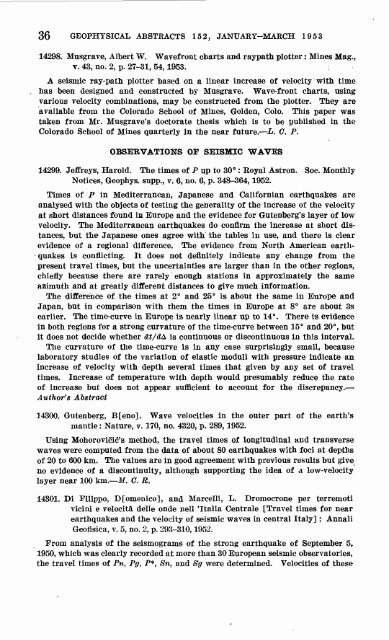Geophysical Abstracts 152 January-March 1953
Geophysical Abstracts 152 January-March 1953
Geophysical Abstracts 152 January-March 1953
Create successful ePaper yourself
Turn your PDF publications into a flip-book with our unique Google optimized e-Paper software.
36 GEOPHYSICAL ABSTRACTS <strong>152</strong>, JANUARY-MARCH <strong>1953</strong><br />
14298. Musgrave, Albert W. Wavef ront charts and raypath plotter: Mines Mag.,<br />
v. 43, no. 2, p. 27-31, 54, <strong>1953</strong>. :<br />
A seismic ray-path plotter based on a linear increase of velocity with time<br />
has been designed and constructed by Musgrave. Wave-front charts, using<br />
various velocity combinations, may be constructed from the plotter. They are<br />
available from the Colorado School of Mines, Golden, Colo. This paper was<br />
taken from Mr. Musgrave's doctorate thesis which is to be published in the<br />
Colorado School of Mines quarterly in the near future. L. C. P.<br />
OBSERVATIONS OF SEISMIC WAVES<br />
14299. Jeffreys, Harold. The times of P up to 30°: Royal Astron. Soc. Monthly<br />
Notices, Geophys. supp., v. 6, no. 6, p. 348-364, 1952.<br />
Times of P in Mediterranean, Japanese and Californian earthquakes are<br />
analysed with the objects of testing the generality of the increase of the velocity<br />
at short distances found in Europe and the evidence for Gutenberg's layer of low<br />
velocity. The Mediterranean earthquakes do confirm the increase at short dis<br />
tances, but the Japanese ones agree with the tables in use, and there is clear<br />
evidence of a regional difference. The evidence from North American earth<br />
quakes is conflicting. It does not definitely indicate any change from the<br />
present travel times, but the uncertainties are larger than in the other regions,<br />
chiefly because there are rarely enough stations in approximately the same<br />
azimuth and at greatly different distances to give much information.<br />
The difference of the times at 2° and 25° is about the same in Europe and<br />
Japan, but in comparison with them the times in Europe at 8° are about 3s<br />
earlier. The time-curve in Europe is nearly linear up to 14°. There is evidence<br />
in both regions for a strong curvature of the time-curve between 15° and 20°, but<br />
it does not decide whether dt/d& is continuous or discontinuous in this interval.<br />
The curvature of the time-curve is in any case surprisingly small, because<br />
laboratory studies of the variation of elastic moduli with pressure indicate an<br />
increase of velocity with depth several times that given by any set of travel<br />
times. Increase of temperature with depth would presumably reduce the rate<br />
of increase but does not appear sufficient to account for the discrepancy.<br />
Author's Abstract<br />
14300. Gutenberg, B[eno]. Wave velocities in the outer part of the earth's<br />
mantle: Nature, v. 170, no. 4320, p. 289, 1952.<br />
Using Mohorovidid's method, the travel times of longitudinal and transverse<br />
waves were computed from the data of about 80 earthquakes with foci at depths<br />
of 20 to 600 km. The values are in good agreement with previous results but give<br />
no evidence of a discontinuity, although supporting the idea of a low-velocity<br />
layer near 100 km. M. C. R.<br />
14301. Di Filippo, D[omenico], and Marcelli, L. Dromocrone per terremoti<br />
vicini e velocita delle onde nell 'Italia Centrale [Travel times for near<br />
earthquakes and the velocity of seismic waves in central Italy]: Annali<br />
Geofisica, v. 5, no. 2, p. 293-310,1952.<br />
From analysis of the seismograms of the strong earthquake of September 5,<br />
1950, which was clearly recorded at more than 30 European seismic observatories,<br />
the travel times of Pn, Pg, P*, Sn, and % were determined. Velocities of these

















